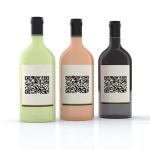Should Your Product Labels Include QR Codes?
This entry was posted on August 18, 2016 .

Utilizing Digital Technologies For Packaging and Labeling
The use of QR, or quick response, codes in product labeling and packaging has gained significant traction over the years. There are many benefits to printing QR codes on labels. This scannable technology allows shoppers to use their smartphones and mobile devices to learn more about an item. The codes can also be leveraged as a promotional and/or marketing tool. For manufacturers and marketers, it offers a solution for minimizing the amount of information they print directly on the package while still providing consumers with the necessary information the brands either want or need to disclose.
When designing custom labels, sellers have a very limited space to work with. And because the packaging and labeling of products plays such an important role in grabbing the attention of shoppers, it is essential to make sure that every inch of the space is used strategically. Many people struggle with deciding which elements they should include, with an obvious concern being that the label will look too crowded or cluttered. However, determining whether or not a QR code would be an effective use of label space can be difficult - and there is no one simple answer. Generally, though, it depends largely on the type of good it is, as well as what industry it exists within.
For example, a lot of the QR code's recent popularity can be attributed to the increased demand for more transparency in food and beverage labels. As Food Dive pointed out, one of the biggest initiatives that have fueled the use of scannable label technology is SmartLabel, a proposed solution to mandatory labeling regulations, such as the new GMO law, that makes it so companies let consumers know all the ingredients and sourcing information they may want to know without directly printing it on the product package. There have been mixed feelings about this strategy, with some arguing that using QR codes is unfair and inefficient because it favors only the shoppers who have smartphones. It's safe to assume that the SmartLabel advocates, which represent a large portion of food and beverage companies, prefer this method because having to disclose the use of certain ingredients or materials in a product may imply it isn't a healthy option, therefore hurting sales.
QR Code Controversy
The benefits of using QR codes and other digital technology in labels are easy to see when you consider how complicated and complex the regulatory environment can be. For example, according to Computerworld, wine makers can legally add as much as 200 ingredients to their wine products without disclosing the use of them on the label.
However, when it comes to deciding whether or not to print QR codes on your labels, there is another important question to consider: Will consumers actually use them? Food Dive reported that, in 2014, 34 percent of consumers in the U.S. had used QR codes while they shopped and that, between 2014 and 2015, the number of scans made per person increased an average of 7.5 percent. Furthermore, the source noted, Hershey conducted research on SmartLabels and found that the general consensus among participants was that the QR codes are valuable when they provide information that the shopper wants to know, rather than a promotional video or marketing content.
On the other hand, The Center for Food Integrity released research report findings that showed only about 8 percent to 9 percent of consumers prefer to receive food information from QR codes. Most preferred instead to have this information available on the product label or package, especially if it relates to the health or safety of the item.
"When we did qualitative work, how consumers want to access information is almost as diverse as the number of consumers, which creates both an opportunity and a challenge," CFI CEO Charlie Arnot explained to Food Dive.
Important Factors To Consider
The important takeaway from the research findings is that, if you are going to include a QR code in the design of product labels, it is crucial to make sure that it is one that provides the consumer with valuable information. Furthermore, in order to determine this, it is necessary to first gain a sound understanding of what exactly your audience and potential customers find meaningful in regard to the type of item you're selling. For example, if it is food or beverages, using the QR code to offer them detailed listings of the ingredients and nutritional values may be a good idea.
Another key factor to consider is whether or not your target audience uses smartphones and, if so, how. Understanding not only the technology-related activity but the purchasing behavior and patterns of your ideal customers is necessary in determining whether QR codes make sense for your product labels.
When you're creating custom labels, you need to make the most of the space you have to work with. If there is a lot of important information that you know some shoppers may be interested in learning about, a QR code can be an effective tool in offering that without making the design look too cluttered.
Request your FREE instant quote today.

 Custom Labels
Custom Labels  Custom Beverage Labels
Custom Beverage Labels  Custom Lip Balm Labels
Custom Lip Balm Labels  Custom Warning & Safety Labels
Custom Warning & Safety Labels  Perfume Bottle Labels
Perfume Bottle Labels  Bumper Stickers
Bumper Stickers  Custom Prop 65 Warning Labels
Custom Prop 65 Warning Labels  Custom Stickers
Custom Stickers